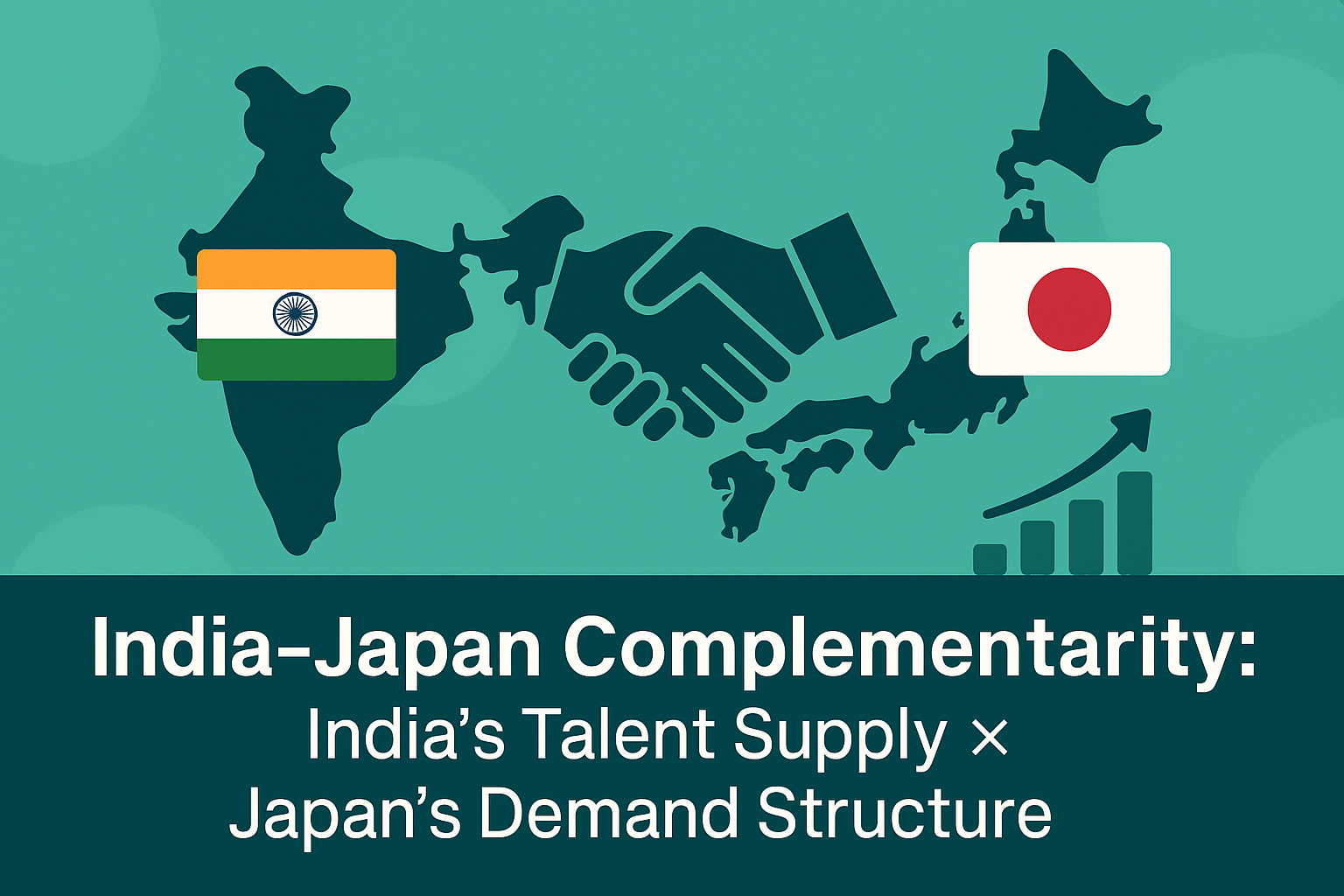Introduction
In the 21st century, India and Japan face very different demographic and economic realities. Japan is struggling with a shrinking workforce due to rapid aging, while India, with its youthful population and globally competitive IT industry, has emerged as a key supplier of human capital. These contrasting trajectories create a unique opportunity: a mutually beneficial partnership in which India can provide skilled talent, and Japan can offer a stable, technologically advanced market. This report examines the structure of this complementarity and its implications for the future of Asia.
Japan’s Structural Demand
1. Demographic Decline and Labor Shortages
Japan’s labor force has been shrinking for years, and projections suggest that by 2030 the country may face a shortage of more than six million workers. The IT and digital sectors are particularly vulnerable, as demand for engineers, data scientists, and cybersecurity experts grows while domestic supply diminishes.
2. Lagging Digital Transformation
Despite being the world’s third-largest economy, Japan has been comparatively slow in adopting digital transformation (DX). Government agencies, financial institutions, and manufacturing companies all face pressing needs to modernize, yet a shortage of digital talent hampers progress.
3. Diversifying Corporate Needs
Japanese firms are increasingly looking for:
- Outsourcing and system integration partners
- Specialists in AI, IoT, and emerging technologies
- Multilingual service providers for global markets
This structural demand creates strong pull factors for foreign talent and service providers, with India positioned as a natural fit.
India’s Supply Capacity
1. A Vast Pool of Human Capital
India produces over one million IT engineers annually, making it one of the largest talent suppliers in the world. Its universities and technical institutes provide a steady pipeline of software developers, data analysts, and engineers.
2. Global Competitiveness
Indian IT giants such as Infosys, Tata Consultancy Services (TCS), and Wipro have already built strong global reputations. Having established success in the U.S. and Europe, these firms increasingly see Japan as the next growth frontier.
3. The Demographic Dividend
With an average age of just 28, India has a demographic advantage unmatched by most major economies. This youthful workforce ensures not only abundant supply today but also a sustainable flow of skilled professionals for decades to come.
The Reality of Mutual Complementarity
1. Indian Firms Entering Japan
Major Indian IT service companies have established offices in Tokyo, Osaka, and Yokohama, providing system development, maintenance, and outsourcing services tailored to Japanese corporate clients.
2. Japanese Firms Hiring Indian Talent
Leading Japanese corporations—including NTT Data, Fujitsu, and Hitachi—have actively recruited Indian engineers to fill critical skill gaps. This employment trend helps Japanese companies accelerate their digital strategies while offering Indian professionals valuable international experience.
3. Institutional Support
Both governments have endorsed closer cooperation, highlighting digital partnerships and startup exchanges as key policy areas. These institutional frameworks reduce barriers to entry and encourage long-term collaboration.
Challenges and Future Outlook
1. Cultural and Linguistic Barriers
Language proficiency and adaptation to Japan’s workplace culture remain significant hurdles. Investment in Japanese-language training and cross-cultural integration programs will be essential to ensure long-term success.
2. Talent Retention and Integration
For India’s professionals, Japan must present itself not just as a temporary job market but as a place to build careers and lives. Clear career paths, competitive compensation, and social support systems will be crucial for retention.
3. Expanding into New Frontiers
Beyond IT services, cooperation can extend to advanced fields such as artificial intelligence, quantum computing, renewable energy, and biotechnology. In these areas, India’s talent and Japan’s technological infrastructure could create powerful synergies.
Conclusion
The partnership between India’s abundant supply of skilled labor and Japan’s structural demand is more than a matter of labor economics—it represents a strategic alignment of two major Asian powers.
- For Japan, India provides a reliable source of human capital to sustain economic growth and digital transformation.
- For India, Japan offers a stable, advanced market where its companies and professionals can expand opportunities and gain international credibility.
This complementarity strengthens the India–Japan strategic partnership, moving it beyond abstract diplomacy into tangible, mutually beneficial cooperation. In a time when Asia is reshaping the global order, the India–Japan relationship demonstrates how two nations can bridge demographic contrasts and economic needs to create a shared pathway toward stability and growth.


